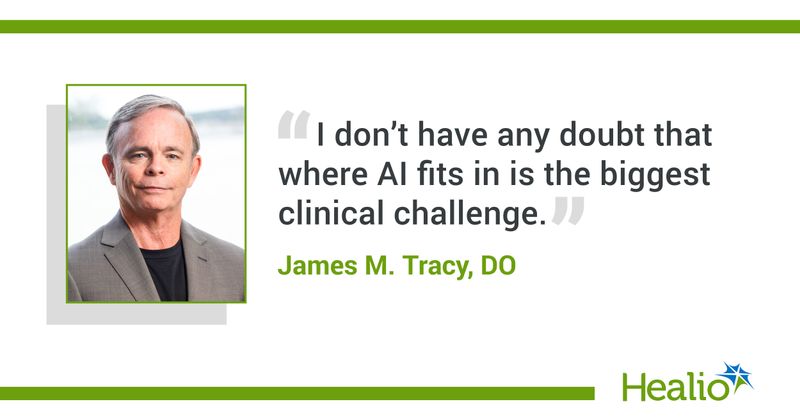Incoming ACAAI president talks allergy, asthma treatment ahead of annual conference
Click Here to Manage Email Alerts
Key takeaways:
- The use of AI in allergy and asthma treatment will be a major topic at the conference.
- Tracy stresses advocacy, servant leadership and integrating therapies as major points in his presidency.
James M. Tracy, DO, clinical professor of pediatrics at University of Nebraska College of Medicine, is set to become the president of the American College of Allergy, Asthma & Immunology ahead of its conference, Oct. 24-28, in Boston.
Healio spoke with Tracy about the current trends in allergy and asthma, the biggest developments and challenges in treatment as well as his priorities as the president of ACAAI.

“There’s a whole new class of drugs and therapies that are becoming available,” Tracy said.
“There are drugs that are small molecules, there are monoclonals, then there are the various types of mRNA and DNA kinds of research and genetic engineering. All of those have become more and more active in our disease space.”
Tracy further emphasized the emergence of AI technology and how it will impact the future of allergy and asthma care as well as challenge it.
“I don’t have any doubt that where AI fits in is the biggest clinical challenge,” he said. “If you follow along with both the objective and the subjective components of this, it’s really an intriguing journey. AI at the moment is really being used for records and efficiency, but how does it change our diagnostic approach to things?
“I think the question with AI ultimately is going to be, are you going to even need a doctor?” he continued. “And if you do need a doctor, what’s the doctor going to do? There’s a human element that I’m concerned may be taken out of the picture prematurely. I don’t want to just be a group of technicians whose job is to stick needles so AI can say where, when and how you best manage it. I think that’s going to be evolving, and how it fits into the broader scheme of things is going to be intriguing. That’s going to be a big piece of this meeting.”
In terms of practice management, Tracy explained that some of the biggest challenges include financial viability and the ability of patients to be able to pay for the care they need.
“Financial viability is huge, especially since we have an aging population,” he said. “Medicare reimbursement has not kept up with inflation. And so, what it does is it creates a situation where there are lots of people who aren’t going to get care because they can’t afford it. And there’s plenty of practices who have trouble making ends meet for a whole variety of reasons.”
The existence of private equity within health care is also problematic, according to Tracy.
“Over the last probably 5 to 10 years, we’ve seen a lot of private equity, which I’m not so sure is a good thing for health care,” he said. “I know I’m not the only one that believes that. I know there’s people who disagree with me on that one, but I think with private equity, all they care about is money.”
In his upcoming tenure as president, Tracy hopes to continue building the ACAAI’s Community & Academic Allergists Partnership in Education & Research (CA2PER) program, which funds collaborations in clinical studies.
Tracy additionally hopes to highlight “over the horizon” therapeutic opportunities —specifically as they relate to small molecules, new monoclonals and mRNA research —servant leadership, and advocacy in the upcoming year.
“I really believe that when it comes to advocating for patients, you have to have patients involved,” Tracy said. “I don’t believe in top-down advocacy. I really do believe that we’re servants. We happen to be physicians and, as such, we’re there to serve our patients and not to serve ourselves. And so how you do that can be manifested through teaching, through research, through just being there, being a good listener.”
But his work does not just stop on advocacy. Making sure that every patient feels cared for and satisfied with their provider is a goal that he tries to instill in others.
“I tell my staff and the physicians that I’ve mentored over the years that you have really one responsibility, and that’s to take care of your patients,” Tracy said. “If they walk out of the office and they don’t feel like they were cared for, then we have not succeeded in our mission. And along the way, if you’re really lucky, they feel like they’ve been cared for and you’ve helped or fixed the problem. That’s your goal. I don’t want to be too simplistic, but that’s really it.”
References:
- ACAAI registration program: 2024 Annual Scientific Meeting. https://annualmeeting.acaai.org/2024/documents/ACAAI_RegistrationProgram2024_v9-FINAL.pdf. Accessed Oct. 3, 2024.
- Community and Academic Allergists Partnership in Education and Research. https://college.acaai.org/get-involved/ca2per_program/. Accessed Oct. 17, 2024.

